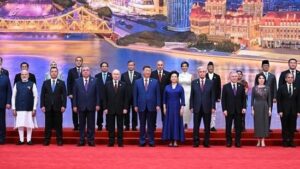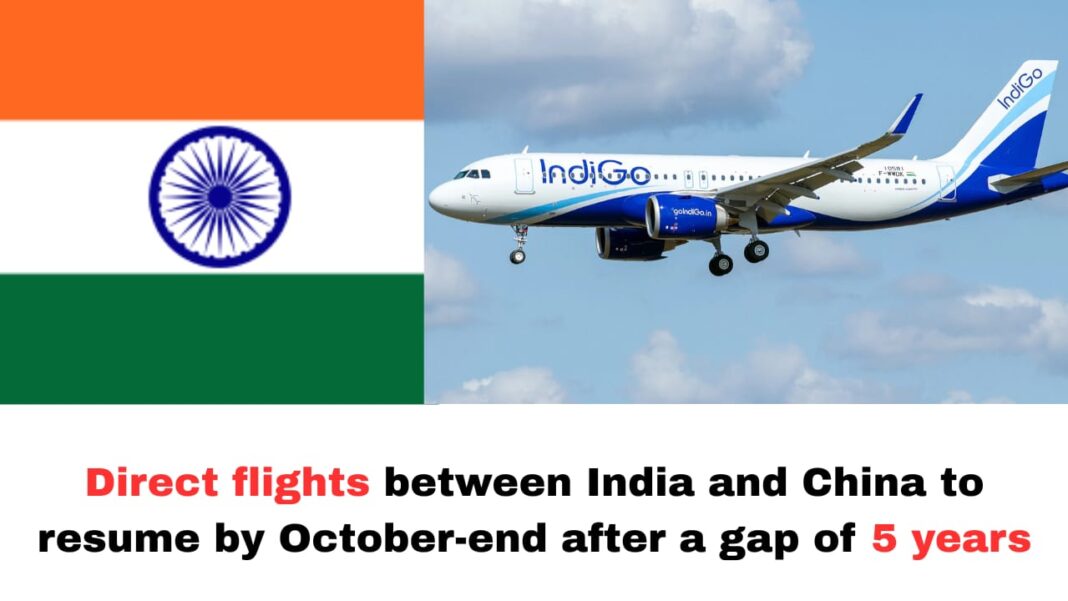Digital News Guru National Desk:
India & China Set to Resume Direct Commercial Flights by Late October After Five-Year Pause
In a notable shift in diplomacy and connectivity, India and China have officially agreed to resume direct passenger flights between designated cities by late October 2025, ending a hiatus that began in early 2020. The resumption follows more than five years of suspended air services, prompted by the COVID-19 pandemic and escalating tensions along their shared border.
Historical Pause & Underlying Tensions
Before the suspension, airlines from both sides regularly operated multiple routes, facilitating people-to-people exchange as well as trade. But in early 2020, with the onset of the global pandemic, flights were halted. Soon after, diplomatic relations further deteriorated following the Galwan Valley clash in June 2020, which led to a protracted military standoff.

Though many international routes reopened by 2022-23 for several countries, flights with China remained stalled, largely because of unresolved border tensions and diplomatic caution.
What’s Changing & Key Details
- The Ministry of External Affairs (MEA) in India confirmed that civil aviation authorities from both countries have conducted technical-level discussions this year on resuming air services and revising the Air Services Agreement. It has been agreed that direct flights between “designated points” in India and China will resume by late October 2025, aligned with the winter flight schedule. However, this remains subject to commercial decisions by airlines and meeting all operational, regulatory, and safety criteria.
- IndiGo, one of India’s largest carriers, is leading the move. It will restart daily non-stop flights between Kolkata and Guangzhou (China) beginning October 26, 2025. A Delhi-Guangzhou route is also being planned, pending regulatory clearances. These flights are to be operated using Airbus A320neo aircraft.
- There is also talk that Air India may resume service between Delhi and Shanghai by year-end, though that remains subject to final approvals.
Why Now? Diplomatic and Strategic Considerations
The decision is not just about restoring travel. It comes amid a broader thaw in India-China relations following recent diplomatic engagements.
- A key moment was Indian Prime Minister Narendra Modi’s visit to China in September 2025 for the Shanghai Cooperation Organisation (SCO) summit. During that visit, both nations emphasized that they are “development partners, not rivals,” and discussed ways to strengthen trade ties, stabilize border relations, and reduce friction.
- The policy shift reflects India’s desire to normalize relations while balancing its geopolitical positioning. Restoring air connectivity helps foster business, tourism, cultural exchanges, and can help manage the large trade imbalance India has with China.

- Internally too, India has pursued technical dialogues to address regulatory, safety, operational, and aviation-bureaucratic hurdles, culminating in a revised Air Services understanding between the two civil aviation authorities.
Implications: What This Means for Travel, Trade, People
Resuming direct flights has multi-fold implications:
- Faster & more efficient travel: Previously, travelers between India and China had to fly via third-country hubs (like Singapore, Bangkok, or Hong Kong), adding time and cost. Direct routes will cut travel times, reduce layovers, and make travel more accessible.
- Economic boost: Improved air links can help trade, tourism, and investment. For many businesses, shorter transit times lower costs and enhance competitiveness. Tourism could see a revival, benefiting hotels, hospitality, cargo, and related services.
- Social and cultural reconnection: People with family ties, students, cultural exchanges (academic, media, arts) will be better enabled. Direct flights also act as symbolic gestures towards normalcy.
- Diplomatic signaling: The move is seen as a signal to the region—both to domestic audiences and international observers—that relations between two populous regional powers are entering a more cooperative phase, though still cautiously. It also reflects how India is balancing its relations with China amidst other geopolitical pressures.
Challenges & What to Watch
Though resumption is welcomed, there are caveats and complexities ahead:
- Commercial viability: Airlines must decide whether routes are profitable. Some routes may not attract enough demand immediately. Regulatory, landing, and overflight permissions must also be cleared.
- Operational logistics: Airports, security, health protocols (especially post-COVID era), slot timings, ground handling must all be ready. Training, safety checks, adherence to cross-border regulations must be ensured.

- Geopolitical risks: Any rise in border tension, diplomatic disputes, or internal political pressure in either country could disrupt or delay implementation. The trust deficit from past years remains.
- Public confidence & perception: Travelers must believe things have stabilized enough to trust booking direct flights. If cancellations/delays occur, it may dampen enthusiasm.
- Balance with other policies: The flights are only one dimension; other issues like trade grievances, border demarcation, visa policy, people-to-people exchanges beyond air travel will also test how durable this opening is.
Conclusion
After more than five years, the resumption of direct flights between India and China marks a significant milestone in restoring connectivity and easing tensions. Starting with the Kolkata–Guangzhou route via IndiGo on October 26, and with other routes to follow, this move reflects a deliberate strategy of normalization in diplomatic, economic, and cultural relations. While there are operational, commercial, and geopolitical hurdles ahead, the agreement offers both nations—and their citizens—a path back toward ease of movement, trade, and engagement.
As India and China begin this next phase, how both sides manage this reopening—through reliable implementation, consistent diplomacy, and constructive engagement—will determine whether this change becomes lasting or merely symbolic.
You May Also Read: क्यूकी शौक बड़ी चीज है : नोएडा के साहिल ने अपनी Fortuner कार के अनोखे नंबर की चाह मे खर्च कीये लाखों रुपये , मिला Vintage नंबर !








